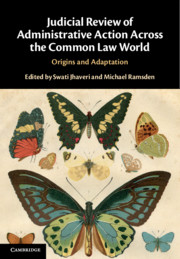Book contents
- Judicial Review of Administrative Action across the Common Law World
- Judicial Review of Administrative Action across the Common Law World
- Copyright page
- Contents
- Contributors
- Foreword
- Acknowledgments
- Table of Cases
- Table of Legislation
- Abbreviations
- Part I Introduction
- Part II Origins and Adaptations of Judicial Review in England
- Part III Origins and Adaptations in the British Isles
- Part IV Origins and Adaptations in North America and Canada
- Part V Origins and Adaptations in the Middle East and Africa
- Part VI Origins and Adaptations in Asia
- Part VII Origins and Adaptations in Australasia
- 17 The Creation of Australian Administrative Law
- 18 English Administrative Law in Aotearoa New Zealand
- Part VIII Conclusion: Interrogating “Common Law” Approaches to Judicial Review
- Index
18 - English Administrative Law in Aotearoa New Zealand
from Part VII - Origins and Adaptations in Australasia
Published online by Cambridge University Press: 19 March 2021
- Judicial Review of Administrative Action across the Common Law World
- Judicial Review of Administrative Action across the Common Law World
- Copyright page
- Contents
- Contributors
- Foreword
- Acknowledgments
- Table of Cases
- Table of Legislation
- Abbreviations
- Part I Introduction
- Part II Origins and Adaptations of Judicial Review in England
- Part III Origins and Adaptations in the British Isles
- Part IV Origins and Adaptations in North America and Canada
- Part V Origins and Adaptations in the Middle East and Africa
- Part VI Origins and Adaptations in Asia
- Part VII Origins and Adaptations in Australasia
- 17 The Creation of Australian Administrative Law
- 18 English Administrative Law in Aotearoa New Zealand
- Part VIII Conclusion: Interrogating “Common Law” Approaches to Judicial Review
- Index
Summary
Of all the common law jurisdictions, New Zealand’s administrative law has probably stayed closest to that of England. Even so, notable differences have developed. The most distinctive part of the local law relates to the Treaty of Waitangi, and the extent to which it constrains the exercise of public powers. On issues common to both jurisdictions, there is a mix of more interventionist or liberal approaches and more conservative ones. A more interventionist approach is notable as regards the effect given to unincorporated international treaties. A more conservative approach can be observed to the human rights legislation and also still, at least to some extent, to the substantive grounds of judicial review (heightened scrutiny unreasonableness, substantive legitimate expectations and mistake of fact). Turning from substance to procedure, access to judicial review is more liberal in several respects. Finally, a notable feature of the New Zealand approach across all aspects of administrative law is a marked resistance to rigid doctrinal categories. Reflecting on these differences, the conservative aspects can be seen in the context of the still fairly unqualified adherence to Parliamentary sovereignty, in the absence of a supra-national source of law such as the ECHR or the EU. The other aspects may be seen as reflecting the national identity as a small polity with informal channels of communication, given to pragmatic solutions, and keen to be seen as a good international citizen.
Keywords
- Type
- Chapter
- Information
- Judicial Review of Administrative Action Across the Common Law WorldOrigins and Adaptation, pp. 327 - 346Publisher: Cambridge University PressPrint publication year: 2021



